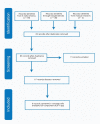A Review of Digital Cognitive Behavioral Therapy for Insomnia (CBT-I Apps): Are They Designed for Engagement?
- PMID: 33809308
- PMCID: PMC7999422
- DOI: 10.3390/ijerph18062929
A Review of Digital Cognitive Behavioral Therapy for Insomnia (CBT-I Apps): Are They Designed for Engagement?
Abstract
There are different ways to deliver Cognitive Behavioral Therapy for Insomnia (CBT-I), of which in-person (face to face) is the traditional delivery method. However, the scalability of in-person therapy is low. Digital Cognitive Behavioral Therapy for Insomnia (dCBT-I) is an alternative and there are tools on the market that are validated in clinical studies. In this paper, we provide a review of the existing evidence-based CBT-I apps and a summary of the published usability-oriented studies of these apps. The goal is to explore the range of interaction methods commonly applied in dCBT-I platforms, the potential impact for the users, and the design elements applied to achieve engagement. Six commercially available CBT-I apps tested by scientifically valid methods were accessed and reviewed. Commonalities were identified and categorized into interactive elements, CBT-I-related components, managerial features, and supportive motivational features. The dCBT-I apps were effectively assisting the users, and the type of interactions promoted engagement. The apps' features were based on design principles from interactive product design, experience design, online social media, and serious gaming. This study contributes to the field by providing a critical summary of the existing dCBT-I apps that could guide future developers in the field to achieve a high engagement.
Keywords: cognitive behavioral therapy; design elements; engagement; insomnia; online.
Conflict of interest statement
The authors declare no conflict of interest.
Figures
Similar articles
-
Disseminating cognitive behavioural therapy (CBT) for insomnia at scale: capitalising on the potential of digital CBT to deliver clinical guideline care.J Sleep Res. 2023 Dec;32(6):e14025. doi: 10.1111/jsr.14025. Epub 2023 Aug 29. J Sleep Res. 2023. PMID: 37642008 Review.
-
Mode of delivery of Cognitive Behavioral Therapy for Insomnia: a randomized controlled non-inferiority trial of digital and face-to-face therapy.Sleep. 2021 Dec 10;44(12):zsab185. doi: 10.1093/sleep/zsab185. Sleep. 2021. PMID: 34291808 Free PMC article. Clinical Trial.
-
Smartphone apps for insomnia: examining existing apps' usability and adherence to evidence-based principles for insomnia management.Transl Behav Med. 2019 Jan 1;9(1):110-119. doi: 10.1093/tbm/iby014. Transl Behav Med. 2019. PMID: 30590862
-
Digital Delivery of Cognitive Behavioral Therapy for Insomnia.Curr Psychiatry Rep. 2019 Jun 4;21(7):50. doi: 10.1007/s11920-019-1041-0. Curr Psychiatry Rep. 2019. PMID: 31161406 Free PMC article. Review.
-
Efficacy of digital cognitive behavioural therapy for insomnia: a meta-analysis of randomised controlled trials.Sleep Med. 2020 Nov;75:315-325. doi: 10.1016/j.sleep.2020.08.020. Epub 2020 Aug 26. Sleep Med. 2020. PMID: 32950013
Cited by
-
Automated stress detection using mobile application and wearable sensors improves symptoms of mental health disorders in military personnel.Front Digit Health. 2022 Aug 23;4:919626. doi: 10.3389/fdgth.2022.919626. eCollection 2022. Front Digit Health. 2022. PMID: 36082233 Free PMC article.
-
Could the use of web-based applications assist in neuropsychiatric treatment? An umbrella review.BMC Psychol. 2025 Mar 26;13(1):302. doi: 10.1186/s40359-024-02263-x. BMC Psychol. 2025. PMID: 40140888 Free PMC article.
-
Investigating the effectiveness of electronically delivered cognitive behavioural therapy (e-CBTi) compared to pharmaceutical interventions in treating insomnia: Protocol for a randomized controlled trial.PLoS One. 2023 May 16;18(5):e0285757. doi: 10.1371/journal.pone.0285757. eCollection 2023. PLoS One. 2023. PMID: 37192176 Free PMC article.
-
Veteran Acceptance of Sleep Health Information Technology: a Mixed-Method Study.J Technol Behav Sci. 2023;8(1):57-68. doi: 10.1007/s41347-022-00287-x. Epub 2022 Dec 13. J Technol Behav Sci. 2023. PMID: 36530383 Free PMC article.
-
The recent history and near future of digital health in the field of behavioral medicine: an update on progress from 2019 to 2024.J Behav Med. 2025 Feb;48(1):120-136. doi: 10.1007/s10865-024-00526-x. Epub 2024 Oct 28. J Behav Med. 2025. PMID: 39467924 Free PMC article. Review.
References
-
- Cooper R. Diagnostic and statistical manual of mental disorders (DSM) Knowl. Organ. 2017;44:668–676. doi: 10.5771/0943-7444-2017-8-668. - DOI
Publication types
MeSH terms
LinkOut - more resources
Full Text Sources
Other Literature Sources
Medical




